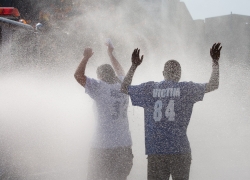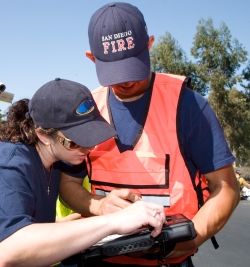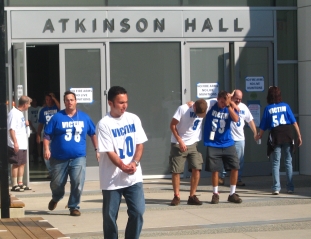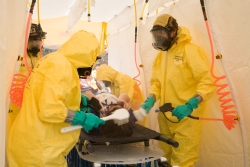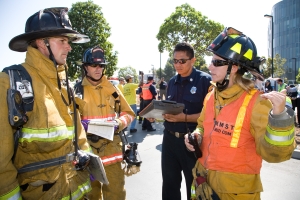Practicing the Art and Science of Emergency Response
|
San Diego, CA, August 29, 2006 -- A mock explosive "flash-bang" at Atkinson Hall the morning of August 22 signaled the official start of a simulated terrorist attack. Approximately 250 law enforcement and public safety personnel went into action at the home of the UCSD division of Calit2, including a rappel from a SWAT helicopter onto the roof.
The San Diego Metropolitan Medical Strike Team (MMST) drill, named Operation College Freedom, was an opportunity for Calit2 researchers to demonstrate and evaluate new technologies which they are developing for the management of disaster and mass-casualty situations. Meanwhile, first responders at the training exercise practiced antiterrorism maneuvers and emergency response to such incidents.
More than 400 people in all participated, including the San Diego City and County police, fire and sheriff departments, SWAT, HazMat, the Metropolitan Medical Response Service, UCSD emergency response, the Calit2 researchers, guests and approximately 100 "patients/victims" who were played by volunteers.
Researchers from three Calit2 projects participated in the drill: the Wireless Internet Information System for Medical Response in Disasters (WIISARD), the Responding to Crises and Unexpected Events (RESCUE) and the ResponSphere projects. The researchers deployed more than a dozen tools, devices and systems for use by, and in support of, disaster response teams.
WIISARD showcased its mass-casualty tracking, triage and medical information management system. The integrated system combines state-of-the-art data collection and display devices, database services (publish/subscribe functionality) and 802.11 wireless communications to produce a consistent, real-time view of the disaster scene.
"It was a fantastic drill, everything we hoped for happened," said Leslie Lenert, the principal investigator of the WIISARD project. "The people worked together and the equipment worked almost flawlessly."
"The first responders were delighted with the interfaces that they had," continued Lenert, "they were able to use the information in a timely way." Lenert is also an associate director of the UCSD Division of Calit2 and a professor of medicine at UCSD's School of Medicine.
To formally evaluate the effectiveness of the WIISARD system in a disaster scenario, two parallel triage, treatment and transport areas were designed. This allowed for direct comparison between the WIISARD system and the standard paper-and-pencil approach. In addition, an independent measurement of the flow and timing of patients was taken using the same ground mat and ID technology used for marathons and bicycle races.
"We don't know yet how the timing of scenarios worked out, but all indications are that it looks very good for the WIISARD team," stated Lenert. "We will be analyzing the data, and very soon will be able to make some real conclusions about the effectiveness of the technologies."
|
The underlying communications infrastructure which provides the foundation for the WIISARD system and other research applications is created with CalMesh. Developed by the ResponSphere project at Calit2, CalMesh is designed to be rapidly deployed at the site of a crisis to restore the communication fabric crucial to emergency response. It creates a wireless bubble of network and Internet connectivity at the scene.
"CalMesh worked very well," noted Rajesh Mishra, the principal development engineer for wireless networking at the UCSD division of Calit2, "including the new features. It worked as advertised." (Link to more information on CalMesh can be found below.)
Calit2 researchers set up a technical operations center near the event Incident Command Post (ICP). Additional details on each of the devices and tools deployed and showcased by Calit2 researchers can be found in last week's press release (link below).
|
As a complementary exercise, the UCSD campus activated its own Emergency Operations Center. Campus first responders (including UCSD police, HazMat and CERT) linked with the San Diego city and county to form a unified command presence at the ICP. There was also a media relations center involving UCSD and Calit2 media relations as well as representatives of the fire and police departments. The event was covered by nearly all local news media.
Calit2 UCSD division director Ramesh Rao pointed out during the debriefing after the exercise that "it is important to understand how technologies help with the interpersonal and interorganizational communications and negotiations that take place in this type of situation."
|
Three types of relationships are important in emergency response, Rao stated: people to people, technology to technology and people to technology. All need the same things to work together successfully: communication, interoperability and integration.
"I think what you have achieved is really unique," UCSD Chancellor Marye Anne Fox told the audience at the debriefing. "I don't know if we have ever had so many people come and cooperate in such a realistic venue."
The debriefing followed the conclusion of the drill and was attended by the law enforcement, medical and public safety team leaders and many of the personnel involved in the exercise, including the researchers.
Chancellor Fox pledged that "we will do our very best to make sure you don't have to come back, under other circumstances." But, she added, "if that unfortunately does happen, we know that you're ready, and we're ready to help you."
Both emergency responders and researchers were pleased with the drill and how helpful it was to all concerned. Calit2 researchers have worked with the MMST during a number of previous drills. "The MMST members have been around to see us grow from a conceptual to a functional system," noted Colleen Buono, a member of WIISARD and a professor of emergency medicine at UCSD's School of Medicine and part of the division of EMS and disaster medicine.
|
Buono continued: "This was a great opportunity to showcase the progress that WIISARD has made. We received great feedback on WIISARD's abilities during the drill."
MMST conducts one major full exercise each year, and this year it was in Atkinson Hall and its environs. MMST is a team of local responders who work together to develop and implement response plans for major urban crises and disasters. It includes all of the local San Diego resources: fire, police, sheriff, bomb squads (police and sheriff), SWAT, harbor patrol, FBI, medical, HazMat and county EMS.
Related Links
August 22, 2006 MMST Exercise
CalMesh
San Diego Metropolitan Medical Strike Team (MMST)
Metropolitan Medical Response System (MMRS)


